In golf, there are many different aspects of the game from driving, pitching, chipping, to hitting irons and bunker shots. However, one of the biggest aspects of golf is putting. It’s almost like a game within a game.
It can be quite a challenge getting the ball into the golf hole especially if you aren’t using the right puttting grip most suitable for you.
But not to worry, in this article I am going to show you 7 different ways you can hold the putter so you can find the one most fitted for you. This will in turn help you hole more putts consistently and better than ever before.
Here are the 7 best putting grips to use:
Table of Contents
1. Standard Putting Grip
A lot of putting grips have been developed just over the last 10 to 20 years. The first one on out list is the standard grip. Still to this day, the standard grip is used by the majority of golfers from amateurs to professional players.
The standard putting grip is very similar to the normal grip when you are hitting a full shot. For right handed golfers, the left hand goes on top with the thumb pointing straight down the front.
The right hand sits underneath the thumb pointing down the front.

Now the standard putting grip comes with a few variations. Sometimes you’ll see players index fingers pointing straight down the side while others have the index finger wrapped around, but with very little differences.
Pros And Cons Of The Standard Grip
The advantage of the standard putting grip is that it is similar to the full shot grip used by a lot of golfers. Therefore, you’d be able to master this grip in no time.
However, one disadvantage of using the standard putting grip is that your wrists can sometimes flick because your left hand lacks structure. This gets worse when you are bit nervous.
Nevertheless this grip is still a good option as a lot of the best players in the world such as Tiger Woods uses the standard grip.
2. Reverse Standard Grip
This is the second most popular grip used for putting. The right hand goes on top of the grip (for right handed golfers) and the left hand goes underneath.
There are variations of the reverse standard grip where the index finger runs straight down the side or wrapped around.
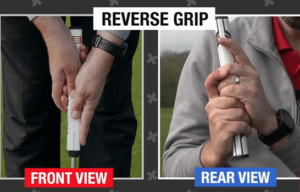
A lot of big names have used this type of grip such as Jordan Speith who is arguably one of the best putters over the last couple of decades.
Pros And Cons Of Reverse Grip
The advantage of the reverse grip is that the left wrist is straighter which minimises the flicking of wrist unlike the standard grip.
The disadvantage of the reverse grip is that it feels different. And when you are not accustomed to a certain type of grip, you may end up playing the shot badly.
While you may find it a little bit awkward at first, the reverse grip is certianly the best choice if you struggle with putting as it keeps the clubface a lot more stable.
3. Prayer Grip
The prayer grip is actually quite popular. The objective is to get both of your hands as level as possible, which looks as though you are clasping your hands when praying. Your thumbs should point straight down which actually helps to keeps the shoulders level and square.
If you are going to try the prayer grip, use a thicker grip as the grip can feel a bit loose which is one of the disadvantages of using the prayer grip.
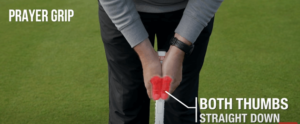
4. Claw Grip
This is one type of grip that I’ve personally used on the shorter putts. With the claw grip, the left hand goes on the top. Whereas the index finger, middle finger and thumb from your right hand pinches the side of the grip.
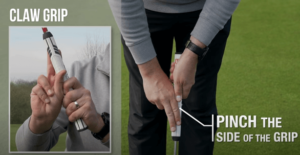
The advantage of this grip is huge. In fact, this type of grip is great if you get twitchy hands when you are nervous.
When you take the palm of your right hand out of the equation and just pinch the club with your three fingers, the hand is less twitchy.
So if you ever find yourself nervous in a game with your hands twitching, then the claw grip could come in handy.
Pros And Cons Of Claw Grip
The advantage of using the claw grip is for players with twitchy fingers. However, this grip comes with it’s disadvantage, and that is, the grip lacks power on longer putts.
So if you are going to try to hole the ball from a farther distance, then this grip isn’t recommended because the ball may not reach the hole.
On the other hand, the claw is great for shorter putts as you don’t need to worry if the ball will reach into the hole.
5. Broom Handle Grip
The broom handle grip was super popular back in the days when handle putters were popular which are the longer ones.
When holding this grip, you will have to completely separate your hands. One hand is placed at the top (left hand for right-handed golfers) while the other hands is placed underneath.
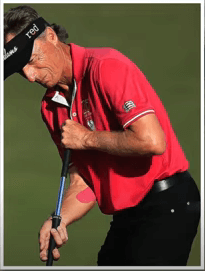
You can have a lot of variations from this grip. You can even still claw or reverse with the broom handle grip. However, this grip is not popular nowadays since anchoring became banned, but it is one grip that is still an option.
6. Arm Lock Grip
Nowadays, you’ll see a lot of brands bringing out putters that are longer in grip. With this grip, you lock it with your forearm. One of the advantage is that it keeps the putter stable
Grip of the putter is locked into forearm
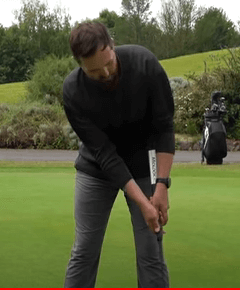
7. Reverse Claw Grip
Just in case you haven’t got enough options, you may want to go for this grip. Personally I haven’t used it, but I know a few tall players use it including players like Tommy Fleetwood.
The left hand goes on top like normal and then you pinch underneath the grip using your index finger, middle finger and thumb from your right hand. This is like the claw grip but instead you are pinching underneath instead of the side of the grip.
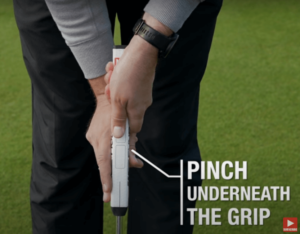
Pros: The right arm stays tucked in close to the body which helps with stability.



